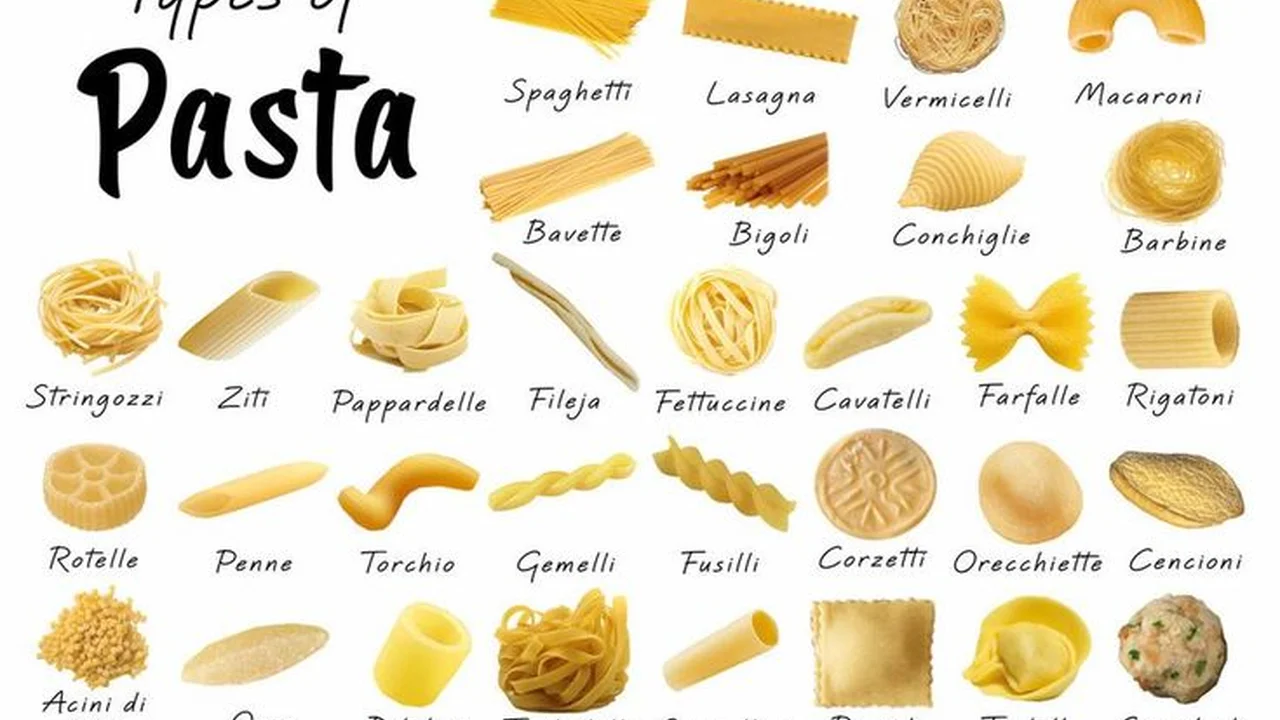Pasta Perfection: A Guide to Different Types of Italian Pasta
Pasta Perfection A Guide to Different Types of Italian Pasta

Worried about what pasta to choose? This guide helps you explore the world of Italian pasta. Discover different shapes, sauces, and regional variations. Learn how to cook the perfect pasta dish and impress your friends.
Understanding Italian Pasta Shapes and Their Best Uses
Okay, let's dive into the wonderfully diverse world of Italian pasta! It's way more than just spaghetti and macaroni, you know? Each shape has its own unique texture and surface area, making it perfect for pairing with specific sauces. Choosing the right pasta can seriously elevate your dish from "meh" to "magnifico!"
Long Pasta: Spaghetti, Linguine, Fettuccine, and More
Spaghetti: The classic! Thin, round strands that are great with lighter sauces like tomato-based marinara or aglio e olio (garlic and oil). Think of spaghetti as a blank canvas – it's versatile and works well with lots of flavors.
Linguine: Slightly flattened spaghetti. Its wider surface area makes it ideal for clinging to pesto or seafood sauces. The extra width helps capture all those delicious flavors!
Fettuccine: Flat, ribbon-like pasta. This is your go-to for rich, creamy sauces like Alfredo. The broad surface area really soaks up the sauce, delivering a burst of flavor with every bite.
Bucatini: Thick, spaghetti-like pasta with a hole running through the center. This unique shape is fantastic with hearty, rustic sauces like Amatriciana (tomato, guanciale, and pecorino cheese). The hole allows the sauce to coat both the inside and outside of the pasta.
Pappardelle: Wide, flat noodles, even wider than fettuccine. These are perfect for robust, meaty sauces like wild boar ragu. The hearty pasta can stand up to the intense flavors of the sauce.
Short Pasta: Penne, Rigatoni, Fusilli, and More
Penne: Cylindrical tubes cut on a diagonal. The ridges and hollow shape make them ideal for absorbing chunky sauces like arrabiata or vodka sauce. The sauce gets trapped inside and outside for maximum flavor.
Rigatoni: Large, ridged tubes. Similar to penne but larger and with straight-cut ends. Great for hearty, chunky sauces like Bolognese or baked pasta dishes. The ridges really grab onto the sauce.
Fusilli: Spiral-shaped pasta. The twists and turns make them perfect for capturing pesto or light tomato sauces. The sauce clings to every nook and cranny.
Farfalle: Bow-tie or butterfly pasta. The shape is fun and visually appealing, making them great for pasta salads or light cream sauces. They add a touch of elegance to any dish.
Orecchiette: Small, ear-shaped pasta. These are traditionally served with broccoli rabe and sausage in Puglia. The shape is perfect for scooping up small pieces of vegetables and sauce.
Cavatappi: Corkscrew-shaped pasta. Similar to fusilli but with a more pronounced spiral. Great for cheesy sauces or baked pasta dishes. The shape holds the sauce well.
Stuffed Pasta: Ravioli, Tortellini, and More
Ravioli: Square or round pasta pillows filled with cheese, meat, or vegetables. Served with butter and sage or a light tomato sauce. The filling adds an extra layer of flavor.
Tortellini: Ring-shaped pasta filled with meat or cheese. Often served in broth or with a cream sauce. These are a classic comfort food.
Agnolotti: Small, pinched pasta pockets filled with meat or vegetables. A specialty of Piedmont, often served with butter and sage. Delicate and flavorful.
Pairing Pasta Shapes with the Right Sauces for the Best Italian Meal
Okay, so you know your pasta shapes. Now comes the fun part: matching them with the perfect sauce! Here’s a quick guide to get you started:
- Light, thin sauces (like marinara or aglio e olio): Spaghetti, angel hair, linguine
- Creamy sauces (like Alfredo or carbonara): Fettuccine, pappardelle
- Chunky sauces (like Bolognese or arrabiata): Penne, rigatoni, shells
- Pesto: Linguine, fusilli, trofie
- Broth-based dishes: Tortellini, ditalini
The Art of Cooking Pasta: Achieving Perfect "Al Dente" Texture
The key to amazing pasta is cooking it “al dente,” which means “to the tooth” in Italian. It should be firm but not hard, offering a slight resistance when you bite into it. Here’s how to achieve pasta perfection:
- Use plenty of water: About 6 quarts of water for every pound of pasta.
- Salt the water generously: This seasons the pasta from the inside out. Use about 1-2 tablespoons of salt.
- Bring the water to a rolling boil: Add the pasta and stir immediately to prevent sticking.
- Cook according to package directions: But start testing for doneness a minute or two before the suggested time.
- Taste the pasta: It should be firm but cooked through.
- Reserve some pasta water: This starchy water is liquid gold! Use it to help emulsify the sauce and create a creamy texture.
- Drain the pasta: But don’t rinse it unless you’re making a cold pasta salad.
- Add the pasta to the sauce: Toss to coat and serve immediately.
Recommended Pasta Brands and Products for Your Italian Cooking Adventures
Now, let’s talk about some specific pasta products you can buy. I'll also give you some ideas of how to use them, and how they stack up against each other.
De Cecco Pasta: A High-Quality Staple
Product: De Cecco Spaghetti No. 12
Description: De Cecco is a well-known Italian brand that uses high-quality durum wheat semolina. Their spaghetti is bronze-drawn, which gives it a rougher texture that helps sauces cling better. It also holds its shape well during cooking.
Usage Scenario: Perfect for classic spaghetti dishes like spaghetti with marinara sauce, carbonara, or aglio e olio. It's a versatile pasta that can be used in a variety of recipes.
Comparison: Compared to Barilla, another popular brand, De Cecco has a slightly better texture and flavor. It's also less likely to become mushy when overcooked.
Price: Around $3 per pound.
Garofalo Pasta: For the Discerning Pasta Lover
Product: Garofalo Penne Rigate
Description: Garofalo is another premium Italian pasta brand. Their penne rigate has a distinctive ridged surface and a slightly chewy texture. It's also made with high-quality durum wheat semolina.
Usage Scenario: Ideal for pasta dishes with chunky sauces like arrabiata, vodka sauce, or Bolognese. The ridges help the sauce cling to the pasta.
Comparison: Compared to De Cecco penne, Garofalo has a slightly more pronounced ridged texture and a chewier bite. It's also a bit more expensive.
Price: Around $4 per pound.
Rustichella d'Abruzzo Pasta: A Taste of Tradition
Product: Rustichella d'Abruzzo Linguine
Description: Rustichella d'Abruzzo is a traditional Italian pasta maker that uses bronze dies and slow drying methods. Their linguine has a unique texture and flavor that sets it apart from other brands.
Usage Scenario: Best served with seafood sauces like clam sauce or shrimp scampi. The texture of the pasta complements the delicate flavors of the seafood.
Comparison: Compared to De Cecco or Garofalo linguine, Rustichella d'Abruzzo has a more rustic texture and a more pronounced wheat flavor. It's also the most expensive of the three.
Price: Around $6 per pound.
Fresh Pasta from Your Local Italian Market
Product: Fresh Ravioli (various fillings)
Description: Fresh pasta is a game-changer! Look for a local Italian market that makes fresh ravioli. You'll find a variety of fillings, from ricotta and spinach to meat and cheese.
Usage Scenario: Cook fresh ravioli in boiling water for just a few minutes until they float to the surface. Serve with melted butter and sage, a light tomato sauce, or a creamy pesto.
Comparison: Fresh pasta cooks much faster than dried pasta and has a more delicate texture. It's also more perishable and needs to be cooked within a day or two of purchase.
Price: Varies depending on the filling and the market, but expect to pay around $8-$12 per pound.
Tips for Storing Pasta Properly to Maintain Freshness
Finally, here are some quick tips for storing your pasta:
- Dried pasta: Store in an airtight container in a cool, dry place. It can last for up to two years.
- Fresh pasta: Store in the refrigerator in an airtight container. Use within 1-2 days.
- Cooked pasta: Store in the refrigerator in an airtight container. Use within 3-4 days.
:max_bytes(150000):strip_icc()/277019-baked-pork-chops-with-cream-of-mushroom-soup-DDMFS-beauty-4x3-BG-7505-5762b731cf30447d9cbbbbbf387beafa.jpg)






